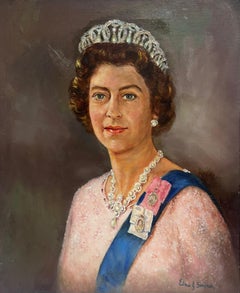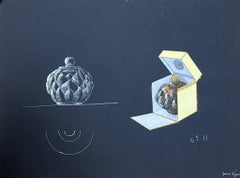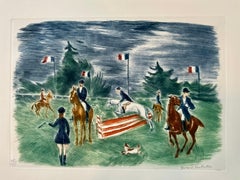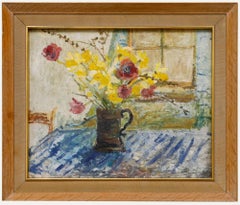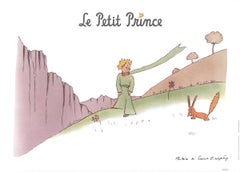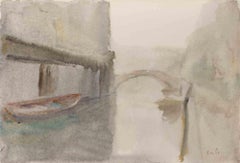20th Century Art
to
25,066
63,250
32,064
31,197
16,097
12,808
Overall Width
to
Overall Height
to
7,559
20,731
156,041
235,384
1,863
2,212
4,753
6,407
5,865
13,211
19,646
25,046
17,329
13,327
5,306
39,164
19,717
14,748
10,641
6,715
5,676
4,395
2,592
1,800
1,135
690
451
100
91
80,300
62,648
7,996
74,209
37,435
27,501
21,753
17,457
13,560
12,524
11,663
10,305
8,728
8,618
7,742
7,726
5,287
4,323
4,189
4,009
3,828
3,795
3,516
48,605
28,802
28,481
28,341
14,794
8,770
1,278
1,179
1,171
1,013
34,606
44,432
83,376
63,797
Period: 20th Century
HM Queen Elizabeth II Portrait British Oil Painting signed oil on canvas
Located in Cirencester, Gloucestershire
The Late HM Queen Elizabeth II
Edne G. Simpson, British 20th century
signed oil on canvas, unframed
painting: 24 x 20 inches
provenance: private col...
Category
Impressionist 20th Century Art
Materials
Oil, Canvas
Mid Century French Glass Ornament In Yellow Box Gouache Painting
Located in Cirencester, Gloucestershire
Glass Ornament
Josine Vignon (French 1922-2022) ...
Category
Impressionist 20th Century Art
Materials
Gouache
Equestrian Scene
Located in Belgrade, MT
This lithograph is a piece from my private collection of 20th Century School of Paris era artists. It is hand signed by the artist and numbered, Guilde de la Gravure, and is in very ...
Category
Contemporary 20th Century Art
Materials
Oil, Engraving, Lithograph
$320 Sale Price
20% Off
20th Century Oil - Daffodils and Poppies
Located in Corsham, GB
This impressionistic still life features a vibrant bouquet of yellow daffodils and deep red poppies arranged in a dark, rustic jug. Unsigned. Presented in a wooden frame with a mater...
Category
20th Century Art
Materials
Oil
The Little Prince and the Fox
Located in Brooklyn, NY
This limited edition color lithograph, titled The Little Prince and His Fox, is a beautiful reproduction from the beloved book Le Petit Prince by Antoine de Saint-Exupéry. This print...
Category
Modern 20th Century Art
Materials
Offset
$60 Sale Price
20% Off
View of Venice - Drawing by Carlo Ravagnan - 1970s
Located in Roma, IT
Watercolor on heavy paper realized by Carlo Ravagnan in 1970s.
Hand signed and dated lower right.
Excellent condition.
Carlo Ravagnan was born in Udine on September 4, 1911, died ...
Category
Contemporary 20th Century Art
Materials
Watercolor
'Archway' — American Modernism, WPA
By Leon Bibel
Located in Myrtle Beach, SC
Leon Bibel, 'Archway', color serigraph, 1939, edition 25. Signed, dated, titled, and numbered ' /25' in pencil. A rich, painterly impression, with fresh colors, on buff wove paper; ...
Category
American Modern 20th Century Art
Materials
Screen
Le Soleil Blanc, Modern Oil Painting and Sand on Canvas by Claude Venard
Located in Long Island City, NY
Claude Venard, French (1913 - 1999) - Le Soleil Blanc, Year: circa 1970, Medium: Oil and Sand on Canvas, signed lower left and titled on verso, Size: 20 x 28.75 in. (50.8 x 73.03 ...
Category
Modern 20th Century Art
Materials
Oil
Aventure d'une libertine X. From The Secret Album Series
By Uwe Ommer
Located in Miami Beach, FL
Aventure d'une libertine X, Paris, 2015
From The Secret Album Series
Edition 6/6 ex. 5 AP.
Unframed
The Secret Album Series
This series is born from a p...
Category
Modern 20th Century Art
Materials
Archival Pigment, Color
Clara, Paris 1997
Located in München, BY
Total Edition of 15
signed and numbered
Also available in:
90 x 120 cm / 35.4 x 47.2 in
120 x 160 cm / 47.2 x 63 in
A black naked model from the front.
Thierry Le Gouès...
Category
Contemporary 20th Century Art
Materials
Black and White
Russian Icon, large painting on canvas
By Peter Kallhof
Located in Cirencester, Gloucestershire
Russian Icon
by Peter Kalkhof (German, 1933-2014)
acrylic painting on canvas, unframed
61cm x 56cm
Stunning original painting by the very well listed German born painter, Peter Kalk...
Category
Abstract 20th Century Art
Materials
Canvas, Acrylic
Andy Warhol 'Shoes, 1980-small' 1992- Poster
By Andy Warhol
Located in Brooklyn, NY
Paper Size: 30 x 23.25 inches ( 76.2 x 59.055 cm )
Image Size: 30 x 23.25 inches ( 76.2 x 59.055 cm )
Framed: No
Condition: A: Mint
Additional Details: Shoes, 1980 by Andy Warhol, pr...
Category
20th Century Art
Materials
Offset
$100 Sale Price
20% Off
Picasso "Linoleum Cut" Framed
Located in Cuauhtemoc, Ciudad de México
Pablo Picasso's linocuts, a printmaking technique using carved linoleum blocks, showcase his graphic genius and exploration of various themes. He used linocut to create posters and a...
Category
Cubist 20th Century Art
Materials
Acrylic
$640 Sale Price
20% Off
Classic British Sporting Art Oil Painting Huntsman on Horseback Winter Landscape
Located in Cirencester, Gloucestershire
Artist/ School: British School, 20th century
Title: Huntsman on horseback, wintery landscape behind.
Medium: oil painting on canvas, oak wooden framed
Framed: 14 x 17.5 inches
C...
Category
Victorian 20th Century Art
Materials
Canvas, Oil
Raymond Pettibon 1980s illustration art (early Raymond Pettibon)
Located in NEW YORK, NY
Raymond Pettibon, "No Mag,'" 1981:
A rare late 70's/early 80's Los Angeles Punk scene publication featuring several stand out illustrations by Raymond Pettibon
Medium: Newspaper mag...
Category
Pop Art 20th Century Art
Materials
Paper, Lithograph, Offset
Walberswick Black Sheds and Fishing Nets Suffolk Coast Landscape 1996
Located in Cirencester, Gloucestershire
Title: Walberswick Black Sheds and Fishing Nets Suffolk Coast Landscape 1996
By Tony Herbert (1927-2024)
Inscribed verso in pencil “Walberswick ‘96 July”
Medium: Watercolor on artist...
Category
Impressionist 20th Century Art
Materials
Watercolor
"Pierre Matisse" lithograph
Located in Henderson, NV
Medium: lithograph (after the painting). Printed in Paris on smooth wove paper at the atelier Mourlot and published in 1954. Size: 9 x 7 inches (228 x 178 mm). Not signed.
Conditio...
Category
20th Century Art
Materials
Lithograph
Spring Walk, Impressionist Oil Painting on Canvas by Lucien Neuquelman
Located in Long Island City, NY
Lucien Neuquelman, French (1909 - 1988) - Spring Walk, Year: 1938, Medium: Oil on Canvas, signed and dated lower right, Size: 13 x 9.5 in. (33.02 x 24.13 cm), Frame Size: 20.5 x ...
Category
Impressionist 20th Century Art
Materials
Oil
"L'Aviation" pochoir for Les Joies du Sport
Located in Henderson, NV
Medium: pochoir. Printed in Paris in 1932 on Velin du Marais paper at the atelier of Daniel Jacomet for the Les Joies du Sport portfolio and issued in an edition of 750. This was pub...
Category
20th Century Art
Materials
Lithograph, Stencil
"Autumn on the Farm" Charles Harold Davis, Fall Colors, Connecticut Hillscape
Located in New York, NY
Charles Harold Davis
Autumn on the Farm, circa 1930s
Signed lower left
Oil on canvas
20 x 27 1/4 inches
Provenance
Private Collection, Florida
Charles Harold Davis was born in Ame...
Category
American Impressionist 20th Century Art
Materials
Canvas, Oil
Chagall, Tribe of Levi, Vitraux pour Jérusalem (after)
By Marc Chagall
Located in Southampton, NY
Lithograph on vélin paper. Inscription: Unsigned and unnumbered, as issued. Good condition, . Notes: From the album, Chagall, Vitraux pour Jérusalem. Published by Musée des Arts Déco...
Category
Expressionist 20th Century Art
Materials
Lithograph
$1,996 Sale Price
20% Off
"Afternoon Picnic" Still Life Out Doors Impressionist Oil Painting with Florals
Located in New York, NY
A whimsical depiction by Martha Walter of a picnic table with flowers, cups, Pepsi bottles, bowls and a basket. The bold colors and strong contrasts make Walter's work so striking an...
Category
American Impressionist 20th Century Art
Materials
Canvas, Oil, Board
Still Life with Pitcher (Nature morte au pichet)
Located in Chicago, IL
This painting is signed and dated by Barnabè in the lower right. Barnabè's still-lives of simple everyday objects such as water pitchers, coffee cups, vases and bowls are painted in ...
Category
Modern 20th Century Art
Materials
Canvas, Oil
Portrait of Black Dancer Darryl Robinson (male nude)
Located in Wilton Manors, FL
Roy Blakey (1930-2024). Portrait of Darryl Robinson, ca. 1972.
Original photographic print on paper, image measures 11 x 14 inches. Framed measurement 12 x 15 inches.
Studio stam...
Category
Realist 20th Century Art
Materials
Photographic Paper
1930's Original Parisian Fashion Watercolor Burgandy Dress With Green Cape
Located in Cirencester, Gloucestershire
Very stylish, unique and original 1930's French fashion design, no doubt of Parisian origin.
The painting, executed in gouache/ watercolor and pencil, is dated to the upper corner ...
Category
Impressionist 20th Century Art
Materials
Watercolor, Gouache, Pencil
Sentada Desnuda, Surreal Painting of a Seated Nude Woman, Mexican Artist
Located in Beachwood, OH
Guillermo Meza (Mexican, 1917-1997)
Sentada Desnuda, 1941
Oil on canvas
Signed and dated lower right
23.5 in. h. x 19.5 in. w.
31 in. h. x 27 in. w., as framed
He was born in México...
Category
Surrealist 20th Century Art
Materials
Oil
'The French Farm' — Mid-Century Modernism
Located in Myrtle Beach, SC
Edward Landon, 'The French Farm', color serigraph, 1942, Ryan 86. Signed, titled, and annotated 'Edition 50' in pencil. A superb impression, with fresh colors, on cream, wove paper; ...
Category
American Modern 20th Century Art
Materials
Screen
French Impressionist Oil Painting of Boats in the Harbor at Saint-Malo
By Fanch Lel
Located in Cirencester, Gloucestershire
Title: French Impressionist Oil Painting of Boats in the Harbor at Saint-Malo
By Fanch Lel (French b. 1930)
Size: 4.5 x 6.75 inches (height x width)
Signed: Yes
Oil painting on cardb...
Category
Impressionist 20th Century Art
Materials
Oil
Large 1970's French Modernist Landscape Oil Painting Green Brown Block Colors
Located in Cirencester, Gloucestershire
French Modernist School, 1977
indistinctly signed oil on canvas, unframed
canvas: 32 x 24 inches
Provenance: private collection, Paris
Condition: a few surface marks but sound and i...
Category
Post-Impressionist 20th Century Art
Materials
Oil
Matisse, Mademoiselle M.A. I, Portraits par Henri Matisse (after)
Located in Fairfield, CT
Medium: Collotype, héliogravure, recto and verso, on grand vélin Renage filigrané paper, as issued
Year: 1954
Paper Size: 12 x 9.25 inches; image size: 9.05 x 6.3 inches
Inscription:...
Category
Modern 20th Century Art
Materials
Lithograph
$716 Sale Price
20% Off
Romeo and Juliet - Lithograph
By Leonor Fini
Located in Paris, IDF
Leonor FINI (1908-1996)
Romeo and Juliet, 1980
Lithograph
Printed signature in the plate
On Vellum 43 x 36 cm (c. 16.92 x 14.1 in)
Excellent condition
Category
Modern 20th Century Art
Materials
Lithograph
The Lament of Icarus Large Signed Oil Painting on Canvas Mythological Nudes
Located in Cirencester, Gloucestershire
'The Lament of Icarus'
Continental School, late 20th century, signed
after the original painting by Herbert James Draper
oil on canvas, unframed
canvas : 36 x 24 inches
provenance: ...
Category
Modern 20th Century Art
Materials
Oil, Canvas
Henri Matisse 'La Tristesse du Roi' Vintage
Located in Brooklyn, NY
"La Tristesse du roi" is a reproduction of Henri Matisse’s 1952 gouache on paper, known for its distinctive cut and collage technique. Reproduced in 1990, this piece reflects Matisse...
Category
Modern 20th Century Art
Materials
Offset
$120 Sale Price
20% Off
Large Cubist Modernist Color French Lithograph Zadkine Figures La Famille
Located in Surfside, FL
Ossip Zadkine (French-Russian, 1890-1967),
limited edition color lithograph on paper titled La Famille (The Family), depicting intertwined figures in a Cubist-inspired style. The pr...
Category
Cubist 20th Century Art
Materials
Lithograph
Orphée Octogone Astrologie
By Jean Cocteau
Located in CANNES, FR
Jean Cocteau ( 1889 - 1963 )
" Orphée " .
terre blanche. circa 1958 .
pendentif terre blanche en relief .
dimensions : 9,7 x 9 cm
Ref: RB6 . page 215 du catalogue raisonné Poter...
Category
Art Deco 20th Century Art
Materials
Ceramic
French Impressionist Harbour Scene with Fishing Boats and Whitewashed Houses
By Fanch Lel
Located in Cirencester, Gloucestershire
Title: French Impressionist Harbour Scene with Fishing Boats and Whitewashed Houses
By Fanch Lel
Size: 15 x 18.25 inches (height x width)
Oil painting on cardboard, unframed
Conditio...
Category
Impressionist 20th Century Art
Materials
Oil
signed original lithograph
By Man Ray
Located in Henderson, NV
Medium: original lithograph. Printed in 1972 on Rives wove paper at the atelier Clot, Bramsen et Georges and published by Philippe Lebaud in a limited edition of 190 for the "Variati...
Category
20th Century Art
Materials
Lithograph
Antique Scottish Highlands Loch Landscape Figure by Cottage signed oil
By Joel Owen
Located in Cirencester, Gloucestershire
The Loch Keepers Cottage
by Joel B. Owen (British, signed and dated 1918)
oil painting on canvas: 20 x 30 inches
original antique gilt frame: 23 x 33 inches
condition: overall very g...
Category
Victorian 20th Century Art
Materials
Canvas, Oil
1950's Large French Oil Painting Poppy Fields in Provence Landscape
Located in Cirencester, Gloucestershire
Poppy Fields, Provence
signed by Max Toutain (1935-2006)
dated and inscribed verso
oil painting on canvas, unframed
canvas : 25.5 x 32 inches
Provenance: all the paintings we have by...
Category
Post-Impressionist 20th Century Art
Materials
Oil
Antique Fine Framed French Impressionist Street Scene Paris Signed Oil Painting
Located in Buffalo, NY
Antique French impressionist Paris street scene signed oil painting. Oil on canvas. Framed. Signed. In excellent original condition. Handsomely framed in a gold giltwood impression...
Category
Impressionist 20th Century Art
Materials
Oil, Board
$1,580 Sale Price
20% Off
French Expressionist Abstract Original Painting Artists Studio Provenance
Located in Cirencester, Gloucestershire
Abstract Expressionist Composition
by Jacques COULAIS (1955-2011)
gouache painting on paper/ card
unframed: 12.75 x 9.75 inches
condition: excellent
provenance: all the paintings we ...
Category
Abstract Impressionist 20th Century Art
Materials
Oil
Destination Unknown 1979 Signed Limited Edition Lithograph
By Ernie Barnes
Located in Rochester Hills, MI
Artist: Ernie Barnes
Title: Destination Unknown
Year: 1979
Print - Lithograph
Size: 25" x 19 ½" inches
Edition: Pencil signed and numbered 24/300
Unframed
‘Destination Unknow...
Category
American Realist 20th Century Art
Materials
Lithograph
Untitled (Black Woman Crouching)
Located in Myrtle Beach, SC
Boris Lovet-Lorski, 'Untitled (Black Woman Crouching)', lithograph, edition 250, 1929. Signed and numbered 16 in pencil. Number 16 of Volume 2, a series of...
Category
Art Deco 20th Century Art
Materials
Lithograph
"Etude" original lithograph
Located in Henderson, NV
Medium: original lithograph. Published in Paris in 1904 by Revue de l'art ancien et moderne. This impression was printed on china paper, and mounted along the top edge by the publish...
Category
Impressionist 20th Century Art
Materials
Lithograph
Mid-Century Still Life Oil on Canvas of Chrysanthemums in Copper Vase.
Located in Cotignac, FR
Mid-Century still life of chrysanthemums in copper vase, oil on canvas signed R Colao bottom left.
A wonderfully colourful and vibrant still life, beautifully...
Category
20th Century Art
Materials
Canvas, Oil
Large Scale French Oil on Canvas Still Life of Flowers, Tulips, Iris and Lillies
Located in Cotignac, FR
Large scale French still life of a vase with flowers by André Vagh Weinmann. The painting is signed and dated bottom right. Presented in a very fine patinated wood frame.
An imposin...
Category
Post-Modern 20th Century Art
Materials
Oil, Canvas
Untitled Geometric Abstract (Minimalism, Red, Black, Collage, ~78% OFF)
Located in Kansas City, MO
Willy Oster
Untitled Geometric Abstract
Mixed Media Collage; Acrylic, Paper
1990
27.55 x 39.37 inches (70 x 100 cm)
Signed, dated and annotated by hand on verso
COA provided
*Condit...
Category
Minimalist 20th Century Art
Materials
Paper, Mixed Media, Acrylic
$111 Sale Price
77% Off
Unitled 11
Located in Brooklyn, NY
Framed in an ornate wood frame with a front profile of 1 1/2 inches and a side profile of 1 inch, this piece is elegantly seated behind a 4-inch mat. This is Edition #669/900, publis...
Category
Contemporary 20th Century Art
Materials
Lithograph
$720 Sale Price
20% Off
Sophia Loren Pouring Champagne
Located in Austin, TX
A classic image featuring legendary Italian film actress Sophia Loren getting ready to pour some champagne into a fancy glass on New Year's Eve.
Sophia Loren was born 20 September ...
Category
Contemporary 20th Century Art
Materials
Archival Ink, Archival Paper, Archival Pigment
Venice Market Scene With Figures and Canopies Original Watercolour Painting
Located in Cirencester, Gloucestershire
Title: Venice Market Scene With Figures and Canopies Original Watercolour Painting
By Tony Herbert (1927-2024)
Signed: Bottom right corner
Medium: Watercolor on paper, unframed
Size:...
Category
Impressionist 20th Century Art
Materials
Watercolor
Venice Street Scene With Figures Market Stalls Tower Original Watercolour
Located in Cirencester, Gloucestershire
Title: Venice Street Scene With Figures Market Stalls Tower Original Watercolour Painting
By Tony Herbert (1927-2024)
Signed: Bottom right corner
Medium: Watercolor on paper, unframe...
Category
Impressionist 20th Century Art
Materials
Watercolor
Ulrica
Located in München, BY
Limited Edition 25
More sizes on request
The photographic work of the internationally well-known Austrian photographer Andreas H. Bitesnich is captivating by its beauty and aestheti...
Category
Contemporary 20th Century Art
Materials
Archival Pigment
Oil Painting Depicting Sunset Over Svolvær, Lofoten
Located in Stockholm, SE
Ivan Bergdahl (1929-2021) Sweden
Sunset, Svolvær, Lofoten (Solnedgång, Svolvær, Lofoten)
oil on board
signed Ivan Bergdahl
unframed: 25.5 x 37.5 cm (ca 10.04 x 14.76 inches)
framed: 36.5 x 48 cm (ca 14.37 x 18.90 inches)
Essay:
Ivan Bergdahl, a renowned Swedish painter born in 1929, captures the essence of the Nordic landscape...
Category
Naturalistic 20th Century Art
Materials
Oil, Board
'Public Building' — American Modernism, WPA
Located in Myrtle Beach, SC
Fred Becker, 'Public Building', wood engraving, c. 1937, edition c. 25. Signed and titled in pencil. A superb, richly-inked impression, on cream wove Japan...
Category
Modern 20th Century Art
Materials
Woodcut
Peintures Chez Iris Clert 1957 certified, stamped by Yves Klein Archives 105/200
By Yves Klein
Located in New York, NY
"...Blue has no dimensions, it is beyond dimensions, whereas the other colours are not.... All colours arouse specific associative ideas, psychologically material or tangible, while ...
Category
Abstract 20th Century Art
Materials
Lithograph
City - 4 , 1977 Large Painting
By Hilo Chen
Located in Rochester Hills, MI
Artist: Hilo Chen
Title: City - 4
Year: 1977
Painting oil on canvas
Size 54 x 54 inches
137 x 137 cm
Contemporary photo-realist painter Hilo Chen (Yee-Lum) was born in 1942 in Taiwan and later became an American citizen. He is noted for his paintings of nudes and flowers. Chen's as painter is nothing less than superb. The skin tones of his nudes seem more "real" than life itself. You feel as though you can almost touch these women who are so oblivious to being observed.
Chen's work is held in public collections at: The Solomon R. Guggenheim Museum, New York, NY; San Jose Museum of Art, San Jose CA...
Category
Photorealist 20th Century Art
Materials
Oil
Matisse, Madame Matisse, Femme au chapeau, Portraits par Henri Matisse (after)
Located in Fairfield, CT
Medium: Lithograph on vélin paper, mounted on vélin paper backing sheet, as issued.
Year: 1954
Paper Size: 12 x 9.25 inches; image size: 9.64 x 7.08 inches
Inscription: Signed in the...
Category
Modern 20th Century Art
Materials
Lithograph
$716 Sale Price
20% Off
Jean-Michel Basquiat Gagosian gallery Los Angeles 1986 (exhibition poster)
Located in NEW YORK, NY
Jean-Michel Basquiat Gagosian Gallery 1986:
Original 1980’s Basquiat exhibition poster, published on the occasion of: Jean-Michel Basquiat at Larry Gagosian Gallery, 510 North Robert...
Category
Pop Art 20th Century Art
Materials
Paper
Slim Aarons 'Sundowners, Cannes' Mid-century Modern Photography
By Slim Aarons
Located in New York, NY
Two bikini-clad holidaymakers enjoy a glass of wine outside the Carlton Hotel, Cannes, 1958.
Sundowners
1958; Printed Later
C print
Estate stamped and hand numbered upon sale out of...
Category
Modern 20th Century Art
Materials
Lambda
Mid Century Chevaux et Cavalières La Nuit Lithograph
By Hoi Lebadang
Located in Soquel, CA
Mid Century Nocturnal Horses with Riders Under Moonlight Lithograph Limited Edition
Compelling nocturnal lithograph of two women on horseback by ...
Category
Abstract Impressionist 20th Century Art
Materials
Paper, Lithograph
$770 Sale Price
30% Off
